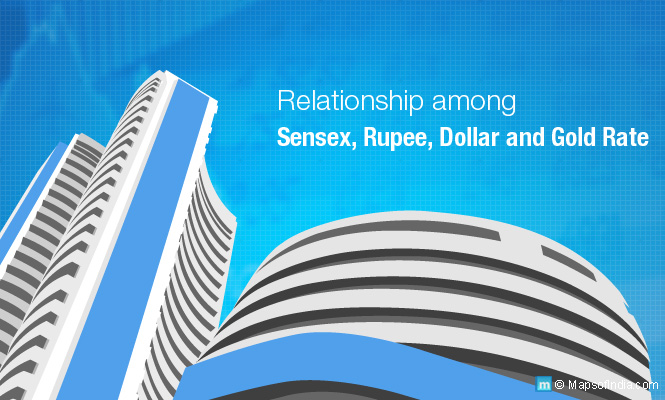Media is full of news reports quoting Finance Minister Arun Jaitley that the Indian economy is in a robust state of revival. “Indian economy can double its size in the next three to three and a half years”, claimed another Union Minister Suresh Prabhu. The last month an IMF report claimed that the Indian economy was on the path to be the fastest growing in the world (growth rate estimate – 7.5 percent) for the second consecutive year in FY 2016. Extreme volatility at the Sensex, crashing gold prices and a dipping INR exchange rate tell us a different story altogether. To understand this seeming contradiction, let us take a look at the key indicators of economic growth and see whether the predicted growth of the nation is a mere perception.
A Look at Dalal Street
Yesterday, on 24 August 2015, the BSE Sensitive Index, commonly referred to as the Sensex, dipped by about 1,600 points – its steepest decline in a single day since 2009. The other key index of the secondary markets, the 50-share Nifty also fell by about 6 percent. Over Rs. 7,00,000 crore of investor wealth was lost at the equity markets. The one question that looms large on the mind of the investors is – Is the Indian economy in bad shape? The capital market as a whole – both the primary market where capital or fund is raised by offer of equity and the secondary market where such equity is traded – holds a great deal of importance in modern trade and commerce. A robust and healthy capital market may thus be indicative of economic growth in a country. It, however, pays to remember that the capital market, more importantly the secondary market, is extremely sensitive and volatile. Our key indices, the Sensex and the Nifty, react, and often sharply, to the rise and fall of other stock markets in Asia and around the world, to corporate decisions and earnings, to government policy announcements, to monsoons and to a variety of triggers.
INR and Currency Exchange
The other key indicator that retailers check on a daily basis is the currency exchange rate, primarily the INR Vs. USD value. Does a strong domestic currency indicate a robust economy? In 2014, the volatility of the Indian Rupee was deemed a key indicator of an unstable economy – so much so that it was one of the primary causes for the downfall of the UPA administration. The devaluation of Chinese Yuan has been looked upon as an indicator of the country’s slowing economy. This approach is also quite short sighted. India’s currency exchange rate or the cost of a US Dollar in Indian rupee terms may be affected by a number of reasons including speculation at the currency markets. In India, the exchange rate primarily decides the import-export scenario. It determines the value of import payments we make, the cost of foreign travel, returns on overseas investments, etc. vis-a-vis the remittances coming into the country, the payments received for exports of goods and services, thus affecting the national CAD (Current Account Deficit) as a whole. In India, technology and pharmaceutical companies are most vulnerable to fluctuations in the domestic currency. While the CAD does have a profound impact on the economic outlook, like others it is also only one indicator of economic health and fails to reveal the entire picture
Gold – the Nation’s Favourite
The truth is gold is India’s favourite investment. Not only does the country rank among the top nations with gold reserves (57.75 metric tonnes gold as of end July 2015), it also is among the world’s largest gold importers. India’s gold import estimates for financial year 2015-16 are pegged between 900 and 1,000 tonnes. Further, it is estimated that India has a silent reserve of 20,000 tons of gold, of which 2,500 tonnes are held by its temples. Silent reserves are the gold that the people of the country hold in the form of coins, bars and jewellery and are not traded on the bullion market. Gold is also the favourite investment of the average Indian who views the equity market as volatile and unstable. Gold is gifted in huge quantities during weddings and on other occasions. Gold rates, however, are also an unreliable economic indicator. The last month the value of RBI’s gold reserves fell by about 44 percent due to the global free fall in gold prices. This does not indicate economic instability in domestic markets but is a result of various factors including China’s move to dump huge gold reserves. Also, the appreciation of India’s gold reserves during the gold Bull Run were immense.
Inflation Data – Month on Month
While “price of onion” jokes are now a part of the Indian social fibre, the woes of inflation are easily deduced from your long grocery bills and longer sighs. The CPI or Consumer Price Index is the key indicator of price rise for the “basket of goods” commonly utilised in the country. It is measured in terms of food and crude price rise in the country. Inflation in the country is also measured in terms of the WPI – the Wholesale Price Index – and the IIP – Index of Industrial Production. Though no longer used as the main inflation computation index, the WPI has traditionally been India’s inflationary measure. Both the CPI and the WPI are influenced by a number of factors such as inadequate monsoons, import duties on certain products, hoarding by middlemen and retailers and even rise/fall in oil prices. Each month the government takes inflation data into consideration while deciding on long and short term policies. The RBI also considers inflation data while reviewing its credit rates. Due to the multiple influences, some of which are highly unstable, inflation alone cannot be regarded as a good measure of the country’s economic growth.
Putting it Together
If all the above are ineffective economic indicators, what then gives us a clear picture of the economic growth in the nation?
Economic growth of a country is a complex quotient of various variable measures. While each of the above factors is an ineffective standalone indicator, together they make up a powerful tool to gauge the growth of India’s economy. Then again together they must be studied over a long term to sensibly predict the turn that the economy is taking. Each of these is influenced in the short term by a number of factors.
Apart from these, a number of other factors such as unemployment rates, GDP (Gross Domestic Product), global influences and even to an extent the socio- political front may determine the economic growth of a nation as vast and varied as India.
Read More:
Is India Heading Towards Another Economic Crisis?
Positive signs for Indian economy – what does it mean?
Important facts about Indian Economy
Rupee Free Fall: Cause and Consequence
Why is the Indian Rupee Depreciating?
What is GST: How will it change India
Investment Risks to Economy – Caution Is the Watchword for RBI
Economic Reforms in India: BJP Government Keen on Taking Tough Calls
A Parallel Economy of Bribe
FDI Norms for NRIs Relaxed – Foreign Investments Anticipated
Will India be affected by the Crisis in Greece?
Effects of Poor Monsoon on the Indian Economy and various sectors
How Inward Remittances impact the Indian Economy
Gold Bond Scheme
Gold Monetisation Scheme






